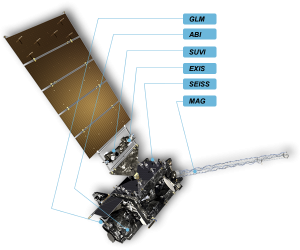The newest of NOAA’s next generation of geostationary weather satellites is ready to go into orbit. GOES-R is scheduled to launch on November 19, 2016 at 5:42 p.m. EST. The satellite will launch from Space Launch Complex 41 at Cape Canaveral Air Force Station, Florida, aboard an Atlas V 541 rocket. You can watch the launch live here on NASA TV and follow the events on the GOES-R Facebook page.

GOES-R Spacecraft. Credit: NASA/ NOAA
The Geostationary Operational Environmental Satellite-R Series (GOES-R) is the nation’s next generation of geostationary weather satellites, and will significantly improve the detection and observation of environmental phenomena that directly affect public safety, protection of property and the United States’ economic health and prosperity. The satellites will provide advanced imaging with increased spatial resolution and faster coverage for more accurate forecasts, real-time mapping of lightning activity, and improved monitoring of solar activity.
There are four satellites in the series: GOES-R, GOES-S, GOES-T and GOES-U. The GOES-R Series Program is a collaborative development and acquisition effort between the National Oceanic and Atmospheric Administration (NOAA) and the National Aeronautics and Space Administration (NASA) to develop, launch and operate the satellites.

Credit: NASA/ NOAA
The GOES-R series satellites will provide continuous imagery and atmospheric measurements of Earth’s Western Hemisphere, total lightning data, and space weather monitoring to provide critical atmospheric, hydrologic, oceanic, climatic, solar and space data. GOES-R will provide images of weather pattern and severe storms as frequently as every 30 seconds, which will contribute to more accurate and reliable weather forecasts and severe weather outlooks. GOES-R’s environmental data products will support short-term weather forecasts and severe storm watches and warnings, maritime forecasts, seasonal predictions, drought outlooks and space weather predictions. GOES-R products will improve hurricane tracking and intensity forecasts, increase thunderstorm and tornado warning lead time, improve aviation flight route planning, provide data for long-term climate variability studies, improve solar flare warnings for communications and navigation disruptions and enhance space weather monitoring.
Quoted from the GOES-R Mission overview – for more information, visit the GOES-R Series Program website.
[youtube https://www.youtube.com/watch?v=6Q7Leqvzfg4&w=1028&h=603]




 Join the Crew!
Join the Crew!
 Escape Velocity Space News
Escape Velocity Space News
0 Comments